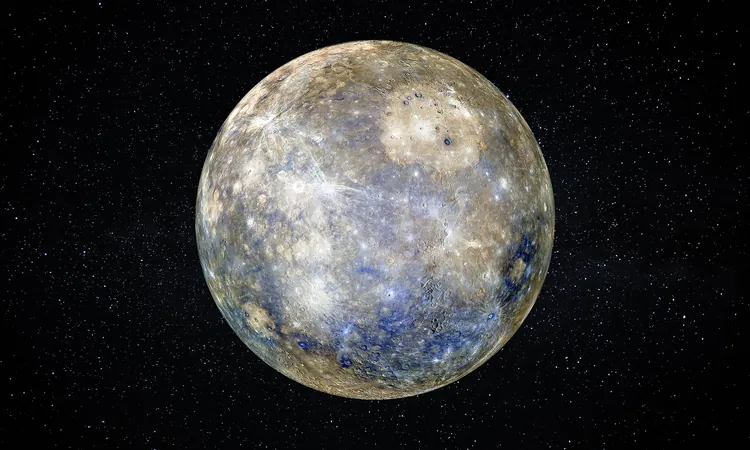
BepiColombo's Stunning Close Flyby of Mercury: Capturing the Secrets of the Solar System's Smallest Planet!
2025-01-15
Author: Jia
Introduction
The European Space Agency and JAXA's BepiColombo spacecraft recently completed a spectacular close flyby of Mercury, the closest planet to the Sun, capturing high-definition images that reveal the fascinating geology and features of this scorching world.
Mercury's Unique Characteristics
Mercury, known for its extreme conditions and being the tiniest planet in our solar system, orbits the Sun in a mere 88 Earth days, marking the shortest year of all planets. Despite this proximity to the Sun's punishing heat, Mercury boasts a surprisingly large iron core that generates a substantial magnetic field, leading to intriguing geological phenomena.
The Flyby
BepiColombo's latest flyby occurred on January 8, 2025, during its sixth approach to the planet. The spacecraft skimmed just 295 miles above Mercury's night side, enabling it to capture remarkable images of the planet's cratered surface, including icy regions that remain in perpetual darkness. These areas could potentially harbor frozen water, which scientists are keen to investigate further.
Mission Significance
This flyby represents a crucial step in BepiColombo's mission. It is part of a series of gravity assists designed to position the spacecraft for its eventual orbit around Mercury in late 2026. Frank Budnik, the Flight Dynamics Manager, expressed satisfaction with the operation, emphasizing that this marks the first instance of consecutive flyby campaigns.
Exciting Discoveries
Some of the most exciting discoveries from this mission center around the polar shadows of Mercury, where some of the coldest temperatures in the Solar System have been measured. The craters, named after iconic figures like Prokofiev and Tolkien, are thought to be places where water ice may exist, adding another layer of intrigue to this rapidly cooling planet.
Geological Insights
In addition to the polar craters, BepiColombo's monitoring cameras revealed extensive volcanic plains, including the Borealis Planitia, which formed from lava flows approximately 3.7 billion years ago. These findings prompt researchers to further ponder Mercury's volcanic history and how it has shaped the planet's surface.
Importance of the Images
The images captured during this flyby are vital for comprehending how Mercury's surface has evolved over billions of years. Notable features such as the massive Caloris Basin, measuring over 900 miles across, demonstrate the incredible impact events that have left their marks on this planet.
Future Analysis
As BepiColombo's flyby campaign nears its end, scientists are excited about the forthcoming analysis of the data. They plan to ascertain not only the presence of water ice in the craters but also how past volcanic activities influenced the geology of Mercury.
Looking Ahead
With the spacecraft's final flybys completed, attention turns to analyzing the newly acquired data. Once in orbit, BepiColombo will utilize advanced instruments to dive deeper into the mysteries of Mercury, unpacking clues about volcanic activity, magnetic fields, and surface chemistry.
Conclusion
The upcoming mission phase promises to unlock even more secrets about this enigmatic planet, leading to a better understanding of Mercury's formation and evolution. As researchers gear up for a new chapter in our quest to explore the cosmos, all eyes are on the seemingly unassuming planet that holds so many untold stories.
Stay Tuned!
Stay tuned as we track BepiColombo’s remarkable journey and the valuable insights it brings from our solar system's smallest planet!



 Brasil (PT)
Brasil (PT)
 Canada (EN)
Canada (EN)
 Chile (ES)
Chile (ES)
 Česko (CS)
Česko (CS)
 대한민국 (KO)
대한민국 (KO)
 España (ES)
España (ES)
 France (FR)
France (FR)
 Hong Kong (EN)
Hong Kong (EN)
 Italia (IT)
Italia (IT)
 日本 (JA)
日本 (JA)
 Magyarország (HU)
Magyarország (HU)
 Norge (NO)
Norge (NO)
 Polska (PL)
Polska (PL)
 Schweiz (DE)
Schweiz (DE)
 Singapore (EN)
Singapore (EN)
 Sverige (SV)
Sverige (SV)
 Suomi (FI)
Suomi (FI)
 Türkiye (TR)
Türkiye (TR)
 الإمارات العربية المتحدة (AR)
الإمارات العربية المتحدة (AR)